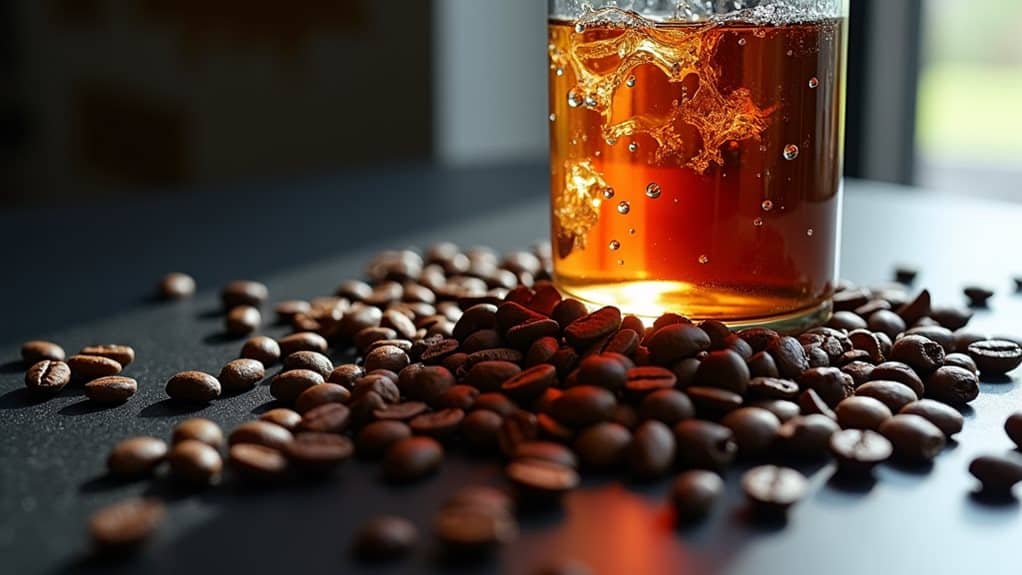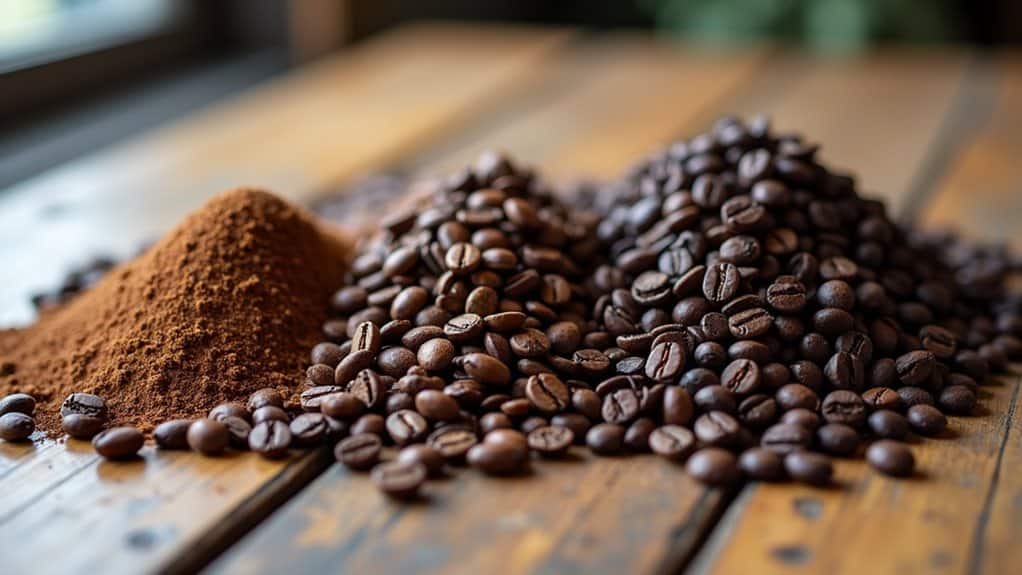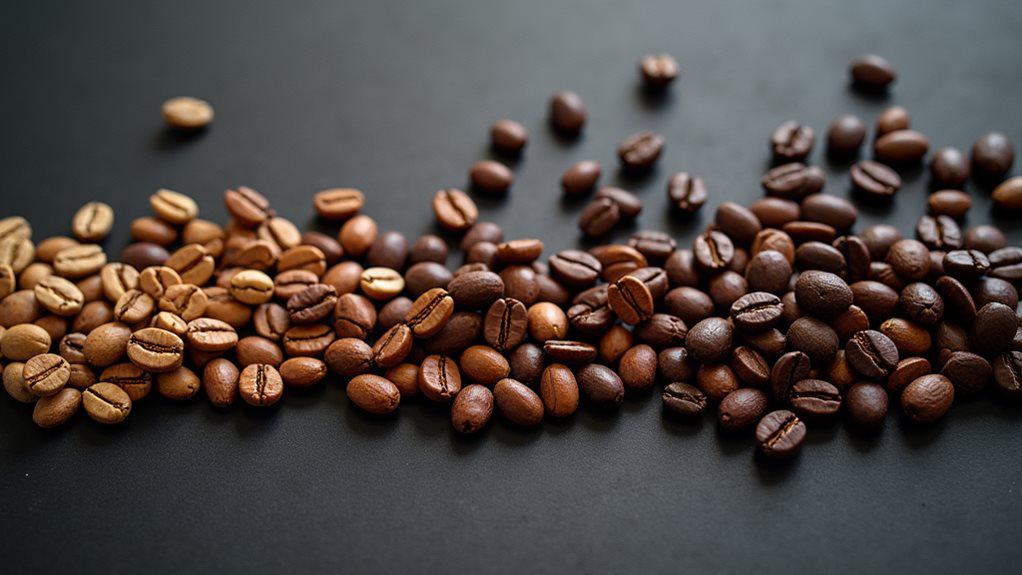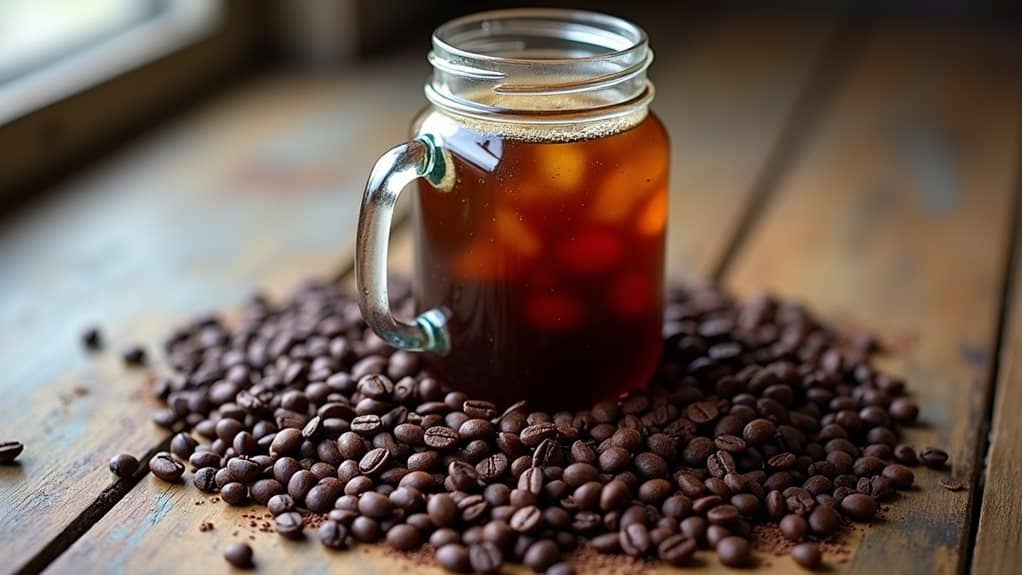For the perfect cold brew coffee, medium to dark roasts typically yield the best results. You'll want to choose beans with rich, chocolatey notes and low acidity, as these characteristics shine in the cold brewing process. Brazilian or Central American beans work exceptionally well, offering balanced flavors and smooth profiles. When preparing your cold brew, use a coarse grind (similar to raw sugar) to prevent over-extraction and bitterness. While light roasts can work, they're often more challenging to brew effectively. Medium roasts strike an ideal balance between complexity and boldness, though your perfect roast level depends on personal taste preferences. Understanding the subtleties of each roast type will help you craft your ideal cold brew experience.
Quick Guide
- Medium roasts offer the ideal balance for cold brew, combining smooth flavors with rich complexity and versatile brewing characteristics.
- Use coarse-ground coffee resembling raw sugar texture to prevent over-extraction and reduce bitterness in cold brew.
- Dark roasts provide bold, chocolatey notes but contain less caffeine, making them suitable for those seeking intense flavor.
- Brazilian and Central American beans work exceptionally well for cold brew due to their balanced profiles and smooth taste.
- Light roasts, while higher in caffeine, are less suitable for cold brew as they can produce weak, acidic flavors.
Understanding Cold Brew Roast Basics

Three main roast levels shape the cold brew coffee experience: light, medium, and dark.
Each roast level brings distinct characteristics to your cold brew. Dark roasts offer rich, smoky flavors with caramelized notes, while medium roasts provide balanced complexity. Internal temperatures during roasting reach up to 464°F in dark roasts.
Light roasts showcase the bean's original flavors but can be trickier to work with in cold brew applications.
Popular Coffee Bean Origins
While roast levels greatly influence your cold brew's flavor profile, the origin of your coffee beans plays an equally important role.
You'll find Brazilian beans dominate the market, accounting for nearly half of global exports. Additionally, the flavor profile of beans can vary significantly based on their origin and processing methods.
Ethiopia, where coffee was first found, offers beans with distinctive fruity notes, while Central American varieties from Guatemala and Costa Rica provide balanced, medium-roast options. This region's coffee history dates back to when berries were discovered by a goat herder who noticed his animals acting strangely after consuming them.
Roast Types Compared

While light roasts showcase bright, acidic notes with higher caffeine content, dark roasts deliver rich, smoky flavors with reduced caffeine levels in your cold brew.
Medium roasts hit a perfect balance between these extremes, offering nutty and caramel flavors that work exceptionally well in cold brew applications. Coarse ground coffee provides the best results when preparing your medium roast blend.
You'll find that medium roasts give you the most versatile cold brew experience, combining the complexity of light roasts with the boldness of dark roasts, while maintaining a consistently smooth taste.
Light Vs Dark Differences
Understanding the differences between light and dark roasts can dramatically impact your cold brew experience.
Light roasts maintain their density and offer crisp, fruity notes, while dark roasts provide bolder, smokier flavors.
You'll notice light roasts create a smoother, more subtle cold brew, whereas dark roasts deliver a full-bodied, intense taste that's perfect if you prefer strong coffee.
Medium Roast Sweet Spot
Ever wondered why medium roast is often called the sweet spot for cold brew?
It's because these beans strike the perfect balance between flavor and smoothness. You'll get a full-bodied taste with hints of caramel, nuts, and fruit, without overwhelming bitterness.
Medium roast reveals more of the beans' natural characteristics while maintaining an easy brewing process, making it ideal for cold brew enthusiasts.
Grinding Tips For Success
Getting your grind size right stands as one of the most critical factors for successful cold brew coffee.
You'll want to aim for a medium-coarse to coarse consistency, similar to raw sugar or kosher salt. Use an adjustable burr grinder for the best results, as it'll provide uniform grounds between 800-1400 microns.
Avoid fine grounds, which can make your brew bitter and over-extracted. A coarser grind allows for a smoother extraction and enhances the overall flavor profile of your coffee, making it less bitter and over-extracted.
Flavor Notes By Roast Level

When selecting the perfect roast for cold brew, each level brings distinct flavor characteristics to your cup.
Light roasts offer bright, subtle flavors with a delicate body, while medium roasts provide balanced sweetness. Medium-dark roasts deliver strong flavors with complex profiles, and dark roasts showcase bold, chocolatey notes with smoky undertones and reduced acidity. Additionally, experimenting with eggnog as a coffee creamer can enhance the richness and festive flavors of your cold brew.
Cold Brew Roasting Considerations
While you'll find ongoing debates between medium and dark roasts for cold brew, the extended roasting time of dark roasts creates oils that contribute to a richer mouthfeel and more consistent flavor. The increased oil content in dark roasts helps achieve better extraction during the cold brewing process, though you'll need to monitor roasting times carefully to prevent bitter notes. Your choice between medium and dark roasts will ultimately depend on whether you prefer a balanced flavor profile or a bold, intense taste that holds up well with milk and sweeteners. Additionally, using higher caffeine levels in darker roasts may enhance the overall experience for those seeking a more stimulating brew.
Medium Vs Dark Debate
Over the years, the debate between medium and dark roasts for cold brew has sparked passionate discussions among coffee enthusiasts.
While dark roasts offer deep chocolaty flavors and smoky aromas, they contain slightly less caffeine at 90mg per serving.
Medium roasts, with 95mg of caffeine, provide a brighter profile with balanced taste, featuring fruity and caramel notes that you'll especially appreciate during warmer months.
Roasting Time Impact
The roasting time and temperature directly shape your cold brew's final flavor profile.
At 240°C, dark roasts develop rich, chocolaty notes with surface oils that create consistent flavors.
Medium roasts, reaching 210-220°C, maintain a balanced profile, while light roasts at 180-205°C offer delicate, acidic notes.
Each temperature milestone contributes distinct characteristics to your cold brew experience.
Oil Content Matters
Understanding oil content proves essential when selecting the perfect roast for cold brew coffee.
While dark roasts have more visible surface oils and create strong flavors, you'll notice that cold brewing doesn't extract these oils as effectively as hot brewing methods.
This actually works in your favor, as the process leaves behind bitter oils and fatty acids, resulting in a smoother, less acidic brew.
Wrapping Up
You'll get the best cold brew results by choosing medium to dark roasted beans from quality origins like Colombia or Guatemala. While you can experiment with different roast levels, remember that medium-dark roasts often provide the sweet spot – conveying both rich chocolate notes and subtle brightness. Keep your grind consistently coarse, and you're well on your way to crafting the perfect cold brew every time.

